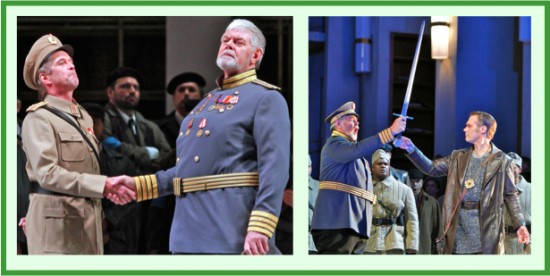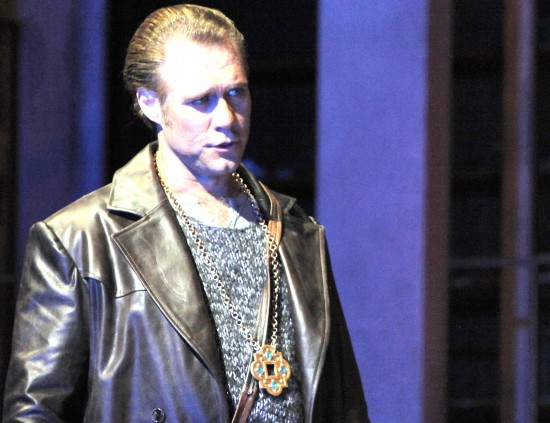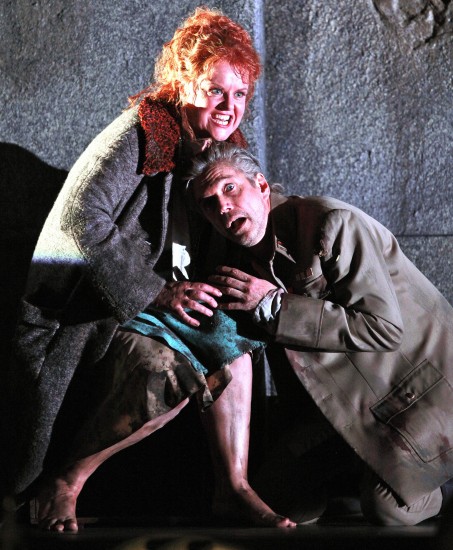There is opera and there is modern opera – and there is¬†Wagner.¬† And as I have just discovered,¬†Wagner doesn’t just mean¬†Wagner’s¬†Ring.¬† Believe it or not, last night, (October 24, 2012) was the first time I had ever seen his¬†Lohengrin.¬† And have I been missing something wonderful!¬†

L to R: Kristinn Sigmundsson (King Heinrich der Vogler) with scepter, Gerd Grochowski (Friedrich von Telramund) in military cap, Brandon Jovanovich (Lohengrin) and Camilla Nylund (Elsa von Brabant), holding hands; Petra Lang (Ortrud), in blue dress; chorus of soldiers and citizens
As usual, the official opera program contains an¬†interview¬†with Director¬†Daniel Slater. Wagner’s libretto was costumed and set in the mythical country of Brabant in the tenth century, but¬†Slater¬†has changed the time to mid-twentieth century and pointed out several parallels to the situation in Hungary in 1956.¬† I suppose this change might bother someone who had seen productions faithful to the original, but I just thought that was a natural setting for the story and for the music.¬† It made for very effective opera.
The story has all the elements of a classic melodrama.  There are bad guys and good guys.  Friedrich von Telramund (Gerd Grochowski), would-be usurper to the throne of Brabant, and his wife Ortrud (Petra Lang), a sorceress, are the bad guys, but oh, they are good singers.
The good guys are a mysterious “knight in shining armor” (Brandon Jovanovich) and Elsa von Brabant (Camilla Nylund), heir-presumptive to the throne of Brabant.¬† To my untrained ear¬†Nylund¬†was also a very good singer, but¬†Jovanovich¬†was in a class by himself – out-of-this-world!
The story has a “trial by mortal combat” (we can’t get totally rid of the 10th¬†century) by which God will decide the truth of Friedrich’s accusation that Elsa drowned her little brother Gottfried so that she could inherit the throne.¬† King Heinrich der Vogler (Kristinn Sigmundsson) accepts the request that¬†he judge the dispute with a sonorous bass voice.
There is black magic and white magic.  The black magic occurs before the opera when Ortrud turns Gottfried (Dylan Zorn) into a swan who brings Lohengrin to Brabant.
At the very end of the opera, Lohengrin’s last act before leaving Brabant is to use his white magic to undo Ortrud’s spell and restore Gottfried (Ivan Kiryakin) to his original human state.
An interesting bit of trivia: Gottfried is played by different boys in his two appearances. The reason has nothing to do with¬†Wagner’s music or words or with¬†Slater’s vision, but is a consequence of California’s child labor laws which state that a child cannot rehearse or perform more than 3 hours in a school day – and Gottfried’s two appearances are about 4 hours apart.¬† This way¬†Dylan¬†can be home close to eight to do his homework and get to bed, and¬†Ivan¬†can get his homework done and have a nap before coming to work at eleven.
Finally, there is mystery.  Who is this mysterious stranger?  The first we hear of him is when Elsa recounts dreaming of him.  Her dream was so real to her that when King Heinrich tells her to chose her defender in the Mortal Combat, she calls him Рand he appears out of nowhere!  Before he agrees to be her knight he makes her swear a solemn vow that she will never, ever, ask him his name or from whence he comes.  Elsa, of course, agrees without giving it a thought.
Lohengrin immediately bests Friedrich, thus proving that God has exonerated Elsa.  However, nice guy that he is, he refuses to kill the scumbag, and urges him to spend is newly-given life in penance.
Fat chance!¬† Instead he complains to Ortrud that he never gets any breaks in life to which she responds, “Quit sniveling.¬† I’ve got a sure-fire formula for victory.¬† We’ll spread a lot of nasty rumors about why he won’t say who he is.¬† That silly goose Elsa will demand that he refute them.¬† He can’t refuse her so he’ll tell and lose all his magic power. Everybody will be miserable, so we two can be happy!”
Throughout the first two acts the stage sets have unobtrusively been just right for the action.¬† But¬†when the overture to Act III begins with the familiar¬†Wedding March, the curtain rises to reveal a perfect gem of a bridal suite.¬† It’s about 20 feet wide, about half that in depth, and 8 feet high, shown with exaggerated perspective.¬† It is suspended in a jet-black infinity with its floor several feet higher than the main stage – it is an exquisite jewel-box of a room.¬† It is empty.¬† Try to visualize the picture below without the wedding couple in the room and without the silhouetted heads of the guests.
The¬†Wedding March¬†continues and the wedding procession wends across the stage, visible only in profile against the lighted room.¬† Elsa and Lohengrin have passed out of sight, but a moment later they enter the bridal chamber, closing the door behind them, and gaze into each other’s eyes.¬† At which point the guests tactfully withdraw.¬† We the audience are not nearly so tactful, but settle salaciously into our seats to see what happens next.¬† It looks promising.¬† Lohengrin takes off his long coat and hangs it carefully on the back of the chair; Elsa carelessly tosses her traveling cloak on the far side of the bed.¬† But neither of them seems to know what to do next so they sing us some lovely music.
Let me backtrack for a moment to digress about the music, particularly the¬†Bridal Chorus and¬†Wedding March¬†which begin the scene.¬† Probably everyone is familiar with the basic melody as played by an infinity of church organists, but the music in the opera is so much more. The whole thing is beautiful, beginning simply with just a hint of the lovely melody to follow, gradually becoming more complex as more instruments and different combinations are woven into the tapestry, finally the whole fully developed theme played by the full orchestra then again with the magnificent San Francisco Opera Chorus added, and finally tapering off as the wedding party passes by.¬† The tune brought back beautiful memories from many decades ago, but it is only a small part of¬†Wagner’s total composition.
Back to the present.¬† As Lohengrin is probably saying to himself, “Mama, what do I do now,” Elsa decides to start a conversation by casually stating that it would be nice to know his true name, totally forgetting that she has sworn a solemn vow that she will never, ever, ask him his name or from whence he comes.¬† Here’s the situation.¬† Lohengrin is not an ordinary mortal.¬† He is a myth, living in a mythical place with his brothers and their father Parsifal.¬† Whenever an innocent maiden is unjustly accused and appeals to him to be her savior, he can temporarily become a mortal with the magical power to always be victorious in a just cause.¬† There is a condition.¬† No one must ever know his true name or circumstances. No problem.¬† Just refuse to answer.¬† But there’s more.¬† If the rescued damsel asks him a direct question, he must answer truthfully, thus losing his magical powers and returning immediately to his mythical status.
The scene in the room becomes increasingly tense.¬† Elsa’s questioning becomes more and more pointed.¬† Lohengrin tries harder and harder to deflect her.¬† The scene is beautifully sung (of course) and brilliantly acted – Elsa becoming increasingly obsessed with finding his name and totally unaware of the terrible consequences – Lohengrin fully conscious of those consequences trying desperately to avoid them.¬† He stalks about the room, coming right up to the walls as if to walk through them.¬† Finally she asks right out: “What is your name?” and he surrenders. ¬†“I’ll tell you, but not here.¬† Compose yourself and we will go before the King so everyone will know.”
But¬†Wagner¬†still has a trick up his sleeve.¬† Friedrich apparently has grown impatient of Ortrud’s smear scheme.¬† Not realizing that it has just been successful, he bursts into the chamber with upraised dagger poised to murder Lohengrin.¬† Elsa cries out in alarm, Lohengrin reacts instantly, avoids the blow, snatches the dagger, and plunges it into Friedrich.
Lohengrin and Elsa appear before the court, he tells his whole story to King Heinrich, and summons the swan to come take him away.
Before they have time to react, Ortrud rushes on the scene to gloat over Elsa, “You’ve forever lost your lover, and since only he could release Gottfried from my spell, you’ll never see your brother again.”¬† She gloated too soon.¬† Lohengrin hasn’t left yet, so he frees Gottfried.¬† Ortrud is frustrated and Elsa is ecstatic to be reunited with her brother – until she looks around, realizes that Lohengrin is gone forever, and dies of a broken heart.¬† The King has had more than enough of Brabant, so leaves with all his court.
And so the curtain descends on the final tableau: Gottfried (Ivan Kiryakin), the new Duke of Brabant, with feet firmly planted and holding the sword Lohengrin gave him, stands ready to rule at one side; his sister Elsa lies dying of grief on the other; through an open doorway we see the silhouette of Lohengrin, walking off towards the horizon.  When it comes back up for the curtain calls half the audience rises with it, and the other half joins in standing ovation when Brandon Jovanovich takes his bow.  We have had a marvelous evening of glorious music, suspenseful plot, and dramatic acting.
Remaining performances are:
Saturday, November 3 2012, 7:00     Tuesday, November 6 2012, 7:00
Friday, November 9 2012, 7:00
To buy tickets go to San Francisco Fall 2012
San Francisco Opera
301 Van Ness Avenue
San Francisco, CA 94102
(415) 861-4008
sfopera.com
Except as noted, all photos by Cory Weaver, San Francisco Opera
This review by Philip G Hodge appeared in sanfranciscosplash.com on November 1, 2012.













